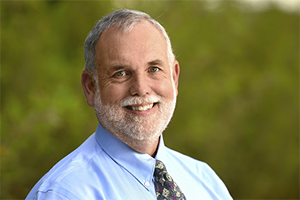
December 15, 2015
Bevin Engelward, Sc.D.
A device called the CometChip greatly improves the quality and speed of DNA repair analysis. Designed by NIEHS grantee Bevin Engelward, Sc.D., from the Massachusetts Institute of Technology (MIT), this device allows the discovery of subtle differences in DNA repair capacity among individuals, as well as advances in basic research.
November 12, 2015
Trevor Penning, Ph.D.
From 2007 to 2011, Trevor Penning, Ph.D., director of the University of Pennsylvania (UPenn) NIEHS Environmental Health Sciences Core Center (EHS Core Center), noticed a drastic rise in hydraulic fracturing, or fracking, across the state of Pennsylvania. Hydraulic fracturing is a method used to extract natural gas and oil from deep rock formations known as shale; it is one part of the broader unconventional natural gas drilling operations (UNGDO) process.
November 2, 2015
Aimin Chen, Ph.D., M.D.
NIEHS grantee Aimin Chen, Ph.D., M.D., studies how prenatal and early childhood chemical exposures affect brain development in children. Chen, an associate professor at the University of Cincinnati College of Medicine, published findings showing that prenatal exposure to polybrominated diphenyl ethers (PBDEs) from flame retardants is associated with lower IQ and more hyperactive behaviors in children.
October 16, 2015
Jay James, Ph.D.
Jay James, Ph.D., launched a start-up company, Picoyune, in 2012 to commercialize a portable mercury detector that he helped develop as an NIEHS Superfund Research Program (SRP) trainee. The reliable and easy-to-use mercury detector can replace the complex laboratory equipment typically used to analyze samples from contaminated sites. It also allows on-site analysis.
October 15, 2015
J. Glenn Morris, Jr., M.D.
J. Glenn Morris, Jr., M.D., and his collaborators have spent the last four years assessing the Deepwater Horizon oil spill’s effects on the Gulf coastline of Florida and Alabama. These regions sustained varying levels of coastal oil influx, ranging from heavy to little or no oil.
October 1, 2015
SenesTech
Small businesses often rise to the occasion and address these challenges by developing novel technologies that are needed to improve public health. SenesTech is an innovative animal health company that offers novel, humane strategies to manage rodent and pest populations by targeting their ability to reproduce.
September 29, 2015
Verónica Vieira, Sc.D.
Environmental epidemiologist Verónica Vieira, Sc.D., uses advanced modeling tools to examine how environmental exposures and disease risk change over space, or location, and time. Her methods and modeling expertise have contributed to a number of national and international environmental epidemiological studies examining risk of autism, birth defects, cancer, and other adverse health outcomes.
September 22, 2015
Gary Patti, Ph.D.
NIEHS grantee Gary Patti, Ph.D., is developing a new technology that could make it much easier and faster to acquire and interpret metabolomics data. Metabolomics — the analysis of metabolites found in the body — can reveal patterns of metabolic changes linked with environmental disorders or diseases.
September 22, 2015
Carolyn Mattingly, Ph.D.
Environmental exposures are thought to play a role in the development of many common diseases, such as asthma and cancer, but how these exposures lead to disease is often unclear. Traditionally, the critical data needed to understand these environment-disease associations better have been scattered throughout the scientific literature, requiring researchers to comb through numerous publications to gain insight on how a chemical exposure may contribute to disease.
June 15, 2015
Frank Gilliland, M.D., Ph.D.
Environmental and preventive medicine specialist Frank Gilliland, M.D., Ph.D., is director of the NIEHS Southern California Environmental Health Sciences Center , where he leads investigations on air pollution research, gene-environment interactions, respiratory health, and cancer epidemiology.
June 9, 2015
Jianghong Liu, Ph.D.
NIEHS grantee Jianghong Liu, Ph.D., is working to understand how early exposure to lead can affect a child’s brain in a way that leads to emotional and behavioral problems.
June 4, 2015
UNC Chapel Hill BCERP
The Breast Cancer and the Environment Research Program (BCERP) is co-funded by NIEHS and the National Cancer Institute and supports multidisciplinary scientists, clinicians, and community partners who study environmental exposures that could predispose women to breast cancer.
May 26, 2015
Joann B. Sweasy, Ph.D.
NIEHS grantee Joann B. Sweasy, Ph.D., vice chair for basic research in therapeutic radiology at the Yale School of Medicine, is internationally recognized for her expertise in DNA repair and cancer biology. Her surprising discovery of a link between a DNA repair gene variant and lupus led to the development of a mouse model for lupus that could help researchers understand how environmental factors affect risk for the disease.
May 26, 2015
Gokhan Mutlu M.D.
People with underlying cardiovascular disease who are exposed to air pollution are at greater risk for developing strokes or heart attacks. Pulmonologist Gokhan Mutlu, M.D., has a longstanding interest in investigating how air pollution causes harm to the lungs and triggers life threatening cardiovascular issues, such as blood clots. His research could lead to new therapies for preventing cardiovascular problems related to air pollution.
April 21, 2015
Roger Peng, Ph.D.
NIEHS grantee Roger Peng, Ph.D., serves as co-director of the data management and statistics core for the NIEHS Center for Childhood Asthma in the Urban Environment at the Johns Hopkins Bloomberg School of Public Health. As an environmental biostatistician, he recognizes the importance of developing statistical methods and using data science skills to address environmental health issues.
April 21, 2015
Manish Arora, Ph.D.
Great challenges persist in valid assessment of exposures that occur during the prenatal period and early childhood. For example, chemicals measured in a pregnant woman’s blood do not always accurately reflect fetal exposure. Environmental epidemiologist and dentist Manish Arora, Ph.D., from the Icahn School of Medicine at Mount Sinai, recognizes the promising value of using teeth as exposure biomarkers to overcome these challenges. He leads investigations that integrate advanced exposure biology methods and environmental epidemiology to understand how exposures that occur during development impact health trajectories later in life.to Top


